
History of Science and Technology in Islam
The Arabic Origin of Summa perfectionis magisterii
And the Other Geber Latin Works
X
Equipment in Arabic Alchemy in the Eleventh Century and in Latin Alchemy at the Thirteenth
The Case of the Aludel (Uthal) in Geber’s Summa
Stapleton’s Criticism of Berthelot
Since Berthelot came out with his theory of a Latin Geber in 1893 [1] there appeared several criticisms to that assumption by some eminent historians of chemistry and alchemy who were more knowledgeable inArabic chemistry and alchemy than Berthelot himself. Prominent among those historians were Holmyard, Stapleton, Partington and others. But for reasons related to sentiments alien to the spirit of true scholarship Berthelot’s conjecture prevailed. The voices of trustworthy scholars were lost among the overwhelming tide. It was a great tragedy in the history of science when conjectures were accepted as facts and were given shape to satisfy irrational emotions. In this article we reproduce parts of a paper about the aludel (uthal) that was published by Stapleton in 1905 only few years after Berthelot proclaimed his conjectures.
In Chapter VI of volume 1 of his work, Berthelot deals with « Appareils Alchimiques Employés Au XIII Siècle et État Réel des Connaissances Chimiques À Cette Époque” which means: “Alchemical Apparatuses Employed at the 13th Century and the Real State of Chemical Knowledge at that Time” Berthelot’s chapter starts with a description and illustrations of the Aludel or Uthal. His source was a Latin manuscript of the Summa at the B. N. of Paris written in 1300 A.D. He took it for granted that the Summa was not for Jabir but for a Latin Geber. This is what he says about the description of the Aludel and its illustrations:
“They are the same shapes of the 13th century apparatuses. But one is not authorized to make them go up earlier than this date, nor are they especially to be ascribed to the (Arab) Geber, as people did until now. Indeed, the authentic Arab treatises which bear the name of the (Arab) Geber contain neither these figures, neither their description, nor the precise descriptions of the operations which are given there.”
This was another hasty judgement of Berthelot. He based all his conclusions on the very limited Arabic sources that were available to him. The word Aludel itself is derived from the Arabic word Uthal, and sublimation was a major process in Arabic alchemy. Indeed, Arabic laboratory equipment was more advanced than what was inherited from pre-Islamic times. In Jabir’s treatises and in the works of other Arab alchemists we read descriptions of elaborate chemical laboratory equipment and delicate operations especially in distillation and sublimation. Knowledge about the laboratory equipment used in Europe in the 13th Century was transferred from Arabic alchemy and was not in any measure more advanced as Berthelot had imagined.
Stapleton discovered in Rampur, India, an Arabic alchemical MS with the title 'Ainu-s-San'ah written in Baghdad in the year 426/1034 by Abu al-Hakam al-Kathi that contained a description and illustrations of the Aludel very similar to those of the 13th century Summa. We reproduce here what Stapleton had to say
Extracts from Stapleton’s Paper [2]
[Special attention may be drawn to two points in connection with the 'Ainu-s-San'ah. The first is the evidence supplied by Chapters III and IV of the great importance that was attached to weights in chemical operations 700 years before the time of Black and Lavoisier.
The second is the remarkable similarity that has been observed between the drawings and description of the Uthāl (Aludel) and its furnace, as given on the last page of the Rampur MS, with those contained in the Summa Perfectionis Magisterii of the author whom M. Berthelot terms the Latin Jābir. So striking indeed is the resemblance between the two that we feel compelled to add a few words of criticism regarding M. Berthelot's belief in the recent origin of the alchemical knowledge current in Europe during the 13th century.
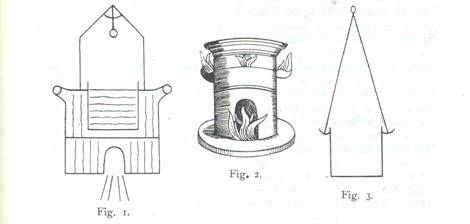
To explain our meaning, we will quote two references to the Aludel that are to be found on pp. 565 and 569 respectively of the edition of the Summa that appeared in Basle in 1572 under the title Artis Chemicae Principes. Of the three figures, Nos 1 and 3 are illustrations of a copy of the Summa that exists in Latin MS. No. 6514 of the Bibliothèque Nationale (written c. 1300 A.D.) [3] while No. 2—that of the furnace alone—is reprinted for purposes of comparison from the Basle edition of the Summa.
" Si igitur volueris multam sublimationis quantitatem elevare, tunc vas aludel tantæ capacitatis invenias, quod illam suscipiat super fundum, ad elevationem unius palmæ. Ad illud coaptes furnum ut suscipiat aludel in medio sui cum distantia parietum suorum per duos digitos. Et furno facto, facies illi X[4]. auriculas, æquè distantes proportione una, ut una æqualitas sit ignis ad omnes partes illius. Tunc vero stipite ferreo in medio fornacis ex transverso in spondilibus ejus firmato, qui à fundo fornacis distet ad extensionem unius palmæ cum .pollice suo, et ad spissitudinem unius digiti, super eo firmetur vas aludel, et circumlinatur ad furnum, quem sequens demonstrat descriptio," (pp. 565 and 566 ; cf. Figs. 1 and 2)
" Ex qua materia et qua forma vas Aludel sit faciendum. Cap. XLIIII.
…..Fingatur ergo concha vίtrea rotunda, cujus fundus sit parvæ curvitatis, et in medio spondilium ejus formetur zona vίtrea circumdans earn, et super illam zonam fundetur paries rotundus æquè distans à conchæ pariete ad grossitudinem cooperculi ipsius conchæ, ita ut in distantia hac cadat paries coopertorii large sine pressura.
Altitudo vero hujus parietis sit ad mensuram altitudinis parίetίs conchæ, aut paulo minus. Formentur vero duo coopertoria ad mensuram hujus concavitatis duorum parietum; æqualia,. quorum longitudo sit æqualis, et sit unius spannæ, et figura eorum figura una, scilicet piramidalis, in quorum capitibus duo æqualia sint foramina : unum scilicet in uno, alterum in altero, in quibus ambobus possit cadere major gallinæ penna, ut hic clarius cernere licebit. Est ergo conchæ vasis intentio, ut possit moveri secundum artificis voluntatem coopertorium illius, et quod junctura sit ingeniοsa, per quam sine lutatione aliqua non pateat spiritibus egressio. " (pp. 569 and 570 ; cf. Fig. 3).
M. Berthelot's comment on this apparatus furnishes an excellent epitome of the views that we desire to criticise. He says:
" Ce sont les formes mêmes des appareils du ΧlIIe siècle. Mais on n'est pas autorisé à les faire remοnter plus haut, ni surtout à les attribuer à Geber, comme on l'a fait jusqu'à présent. En effet, les traités arabes authentiques qui portent le nom de Geber ne renferment ni ces figures, ni leur description, ni l'exposé précis des opérations qui s'y accomplissent. Cependant, elles offrent de l'intérêt, même lorsqu'on en limite la date au ΧΙΙΙe siècle." [5]
To these statements the 'Ainu-s-San'ah lends no support, whilst the similarity in principle between the aludel and furnace described above, and the uthāl and mustauqad of the last pages of our analysis, proves that so far as instruments are concerned, M. Berthelot has over-estimated the inventive capacity of the Middle Ages. Agreeing, as we do, with M. Berthelot that the Summa was finally moulded into its present form during the 13th century, two deductions seem necessarily to follow from this similarity. One is that the contents of the Summa were derived from previously-existing Arabic works on alchemy: the other, that in the 200 years or more that elapsed between the writing of the 'Ainu-s-San'ah in Baghdad and the compilation or editing of the Summa in Spain little or no progress in alchemy occurred.
If these deductions are true, what is to prevent the ultimate affiliation of the Summa with an authentic work of Jàbir ? [6] ]
*****
Description of the ' Uthal' ( Αludel), with its Furnace in 'Ainu-s-San'ah.
[The treatment of a mixture of various substances is being described.]
Having pounded it (i.e., the mixture), you take the three pots of the Uthāl which are of this shape, the length of each being a cubit [7], the aperture one span, and the lips projecting about four finger-breadths. They are constructed by potters of ghadhār [8], and are glazed on the inside.
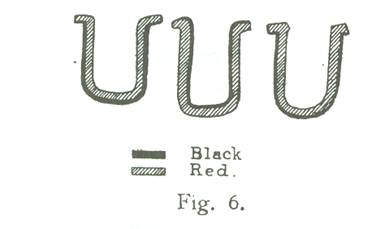
In addition, take three round-bottomed covers, also made of baked ghadhār, but unglazed. Their sides are pierced with a hole at four fingers' distance from the top, measuring towards the rim, the size of the hole being such that a stick of the thickness of a bodkin can enter, to extract the moisture and by means of which the progress of the sublimation may be studied. The diameter of the covers is exactly the same as that of the lips of the uthāl.
If these vessels cannot be procured, you take (a) a cup made of ghadhār, or a Sàghar [9] and (b) a large green jar or a Bustuqah [10], of the capacity of two dauraqs of water, the weight of each dauraq being 1040 dirhams. You cut it (i.e., whichever one of the latter you choose) into two halves with a saw and take the lower half for conversion into an uthal
The method of doing this is as follows. You prepare a large disc (turs) of the Clay of Wisdom [11], οf the breadth of two spans and the thickness of a thumb, and while it is still moist, you invert on its centre the lower half of the jar. By exerting a little pressure, you obtain the measure of the circumference and its mark is impressed. After removing the jar, you take the cup of ghadhār, and invert it on the disc, pressing it down so that it may also leave its mark.[12] This in turn is removed, and the layer left in the shade to dry. When it is well dried, you take it and having cut out the centre with a knife up to the limit of the mark of the jar, you mount it (i.e., the ring of clay that remains) on the top (?) of the lower half of the jar, just like the lips of the pots made of ghadhār. The joint is luted with clay, and when thi is dry, the instrument resembles in shape the ordinary uthāl. It is then taken and half covered with clay of wisdom' to the thickness of a thumb. You also affix, half-way up, four handles of clay so that it may rest on the `Mustauqad' (furnace). Finally the clay is allowed to dry.[13]
You next build for this uthāl, a round mustauqad, similar in appearance to the mustauqad of the sweetmeat sellers, having a small door for the fuel and two openings on the right and left, at the height of a shakankah [14] from the ground for the smoke to go out of. The height of the top of the mustauqad from the ground is two spans and the breadth of the aperture three spans.[15]
The uthàl is mounted on the mustauqad according to the annexed figure. Between its sides and those of the mustauqad there is a space of four fingers for the tongue of the flame to play in, and between the bottom of the pot and the ground a distance of a span. You must also make certain of the junction between uthāl and mustauqad by covering in with clay all round.[16]
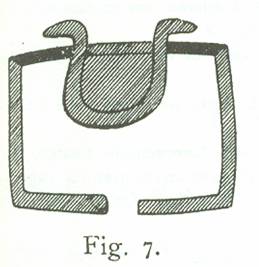
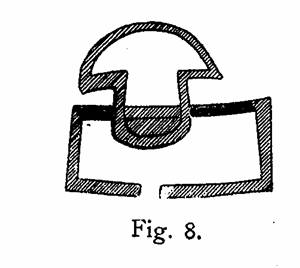
When the uthal is properly fixed in position, you take a little Isfidaju-l-Juss (shell lime) and having pounded it up with water, you smear it on the surface of the lip and leave it. Over this you sprinkle a little salt water, and then gently polish the surface with a polisher made of glass, in such a way that nothing is broken. After these preliminaries, two ratls of the medicines that you wish to sublime--and nο more—are placed inside, for if you introduce a large amount, it will refuse to volatilise. You next take the cup of ghadhar, and having to enter, at three fingers' distance from its rim, measuring towards the top, you invert the cup on the mark that is on the lip of the uthal, according to the annexed figure. Then you take a little of the moistened isfidàj, and pour it into the joint" .
[At this point the MS. comes to an end.]
*****
The Uthal
In the Syrio-Arabic alchemical MS. published by Duval in Vol. II. of Berthelot's Le Chimie au Moyen Άge, p. 69
Sublimation by means of the Mustauqad.
Sublimation is carried on in a pot of earthen ware, a pot of glass, or a pot of ghadhar. These are the points to be observed:
(a) The pot should be luted with ' clay of wisdom' besides being encircled with a collar of clay of the width of two fingers, so that it may stand firm on the mustauqad.
,(b) The mustauqad should be round, with a door one: span long by one span broad, and two apertures, one on each side, for smoke, and for air to enter
(c) Between the bottom of the pot and the Mustauqad there should be a span's breadth, the collar' of the pot being affixed at one-third of the distance from the top.
(d) If the pοt is of glass, it should have a wide projecting lip of the breadth of four fingers;, Its, cover, which will close it completely (?), should also be of gIass."
As there is little doubt that the Syrio.Arabic MS. is a volume of selections and not a single homogeneous treatise, the marked differences between the references to the uthal contained in this extract and those given in note No. 13 of the endnotes below, ίs very probably due to their being drawn from different sources,
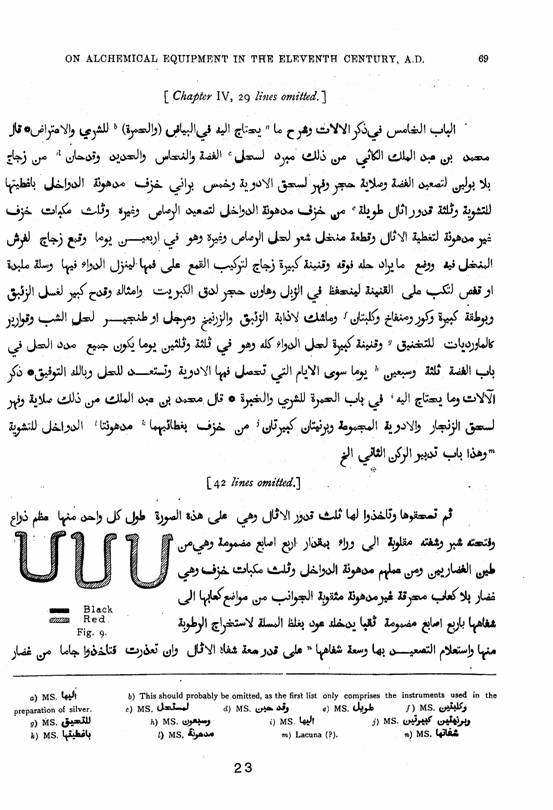
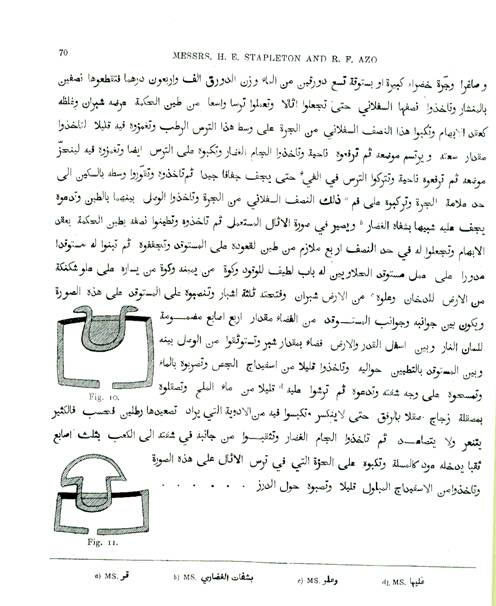
*****
Endnotes
[1] Berthelot, M., La Chimie au Moyen Age, Vol. I, Paris, 1893.
[2] Stapleton, Henry, E.; Rizkallah F. Azo, Alchemical Equipment in the eleventh century A.D., Memoirs of the Asiatic Society of Bengal ( Calcutta), 1, 1905, pp. 47-70, 1 pl.. Reproduced in Natural Sciences in Islam, vol.61, Chemistry and Alchemy , Texts and Studies, published by Fuat Sezgin, Frankfurt, 2001, pp. 1- 25.
[3] Fac-similes of these figures are to be found in Berthelot's La Chimie au Moyen Age,I, pp. 149 and 150.
[4] Probably a mistake for IV, as Fig. 2 shows. Manget, in the reprint of the Summa in his Bibliotkeca Ckemica Curiosa,1, p. 532, also reads `quatuor.'
[5] Loc. Cit. p. 149.
[6] It should be added that M. Berthelot's disbelief in Jabir being the author of the Suntma is mainly based on a consideration of the mystical Kitabu-r-Rahmah (Βοοk of Pity). So far as we can ascertain he has never replied to Leclerc's suggestion that the original of the Summa is the Kitabu-l-Khalis (Book of the Essence), of which a copy exists in Arabic MS. No. 1083 of the Bibliotheque Nationale (cf. Histoire de la Médecine Arabe, I, p. 74 ; Haji Khalfa's Kashfu-.dh-h Dunun, V, p. 79).
[7] Lit. ' the arm bone.'
[8] A special kind of greenish clay.
[9] A large drιnking cup (Persian).
[10] An elongated jar for storing butter and other supplies (Persian). Taking a ratl equal to 1 lb. of water, the capacity of the bustuqah here mentioned would be a little more than 11/2 gallons.
[11] Earlier in the ' Third Pillar' of the 'Ainu-s-San'ah, it is mentioned that the special luting clay (' Clay of Wisdom,') employed by Muhammad ibn 'Abdi-l-Malik, consisted of two-thirds Tinu-l-Hurr (clay, free from stones ; see Ibnu-l-Baitar, trans. cit., II, ρ. 424) and one-third of a mixture of dried dung and chopped animals' hair. From Bar Bahlul, loc. cit., p. 137, it would seem probable that the stone-free clay used in making ' clay of wisdom' came from Assuan in Upper Egypt.
[12] As is evident from what follows, the rim of the cup is of larger diameter than that of the jar.
[13] With this compare the following extract from the contemporary Syrio-Arabic alchemical MS. published by Duval in Vol. II. of Berthelot's Le Chimie au Moyen Άge, p. 69.
Take a pot shaped like a ' Burmah,' of the length of one cubit, and breadth two bands, and invert it on a level surface. After throwing sifted ashes round it for the space of a hand and a half, you remove the pot, and cover the ashes with clay up to the same limit. When the ring of clay is dry, lift it up and polish its surface with ' Isfidaj ' and white of egg. Polish it a second time.
[Here comes an unintelligible sentence. The copyist also seems
to have omitted a sentence describing
the fixing of the ring on the top of the pot.]
" Then invert the pot of the uthal on its face and after covering it evenly with clay all round, encircle the pot with wings, one band below the shelf (turs, lit. 'disc'), in order that the flame of the fire may not affect whatever settles on the shelf, and so burn and damage it. Finally invert the cover on the uthal. There is a mystery in this which we shall mention when giving an account of sublimates."
[14] This measure of length does not seem to be mentioned in any Persian or Arabic dictionary
[15] The home-made uthal is apparently broader than the ready-made uthal mentioned at the beginning of this section, as in the case of the latter, the distance between the sides of the uthal and mustauqad would be one span. Little reliance can be placed on the drawing, for according to the description, only half the length of the uthal should be within the mustauqad.
[16] Cf. the Syriο-Arabic MS., loc, cit., Text, p. 79
Copyright Information
All Articles and Brief Notes are written by Ahmad Y. al-Hassan unless where indicated otherwise.
The design of this website does not belong to Ahmad Y. al-Hassan, the design was based on common webdesign elements.
All published material are the copyright of the author (unless stated otherwise) and may not be published or reproduced in part or in whole without the express written permission of the author.